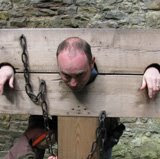Cross-posted for completeness from our MoL blog
*************************************************
Hi. My name is Jeremy and I’m a museum web developer. There, I’ve said it. I’m a keyboard-jockey burdened (or as I see it blessed) by at least two sorts of geekdom: a late-born pleasure in ‘pooters; and a long-standing love of museums, and of the special sort of residue of our world that flocculates there (especially, it must be said, “real” things).
Seven-odd years ago I thought about setting up a museum-orientated web development company, to be called MuseioNet or some such nonsense. Thankfully it never got much beyond a cheesy name, because now I’m starting at least to get an idea of what I don’t know about the subject of building web-based resources for museums. I would have crashed and burned horribly if I’d tried to go it alone back then. I’ve been at the Museum of London about 6 years now, learning on the job. That’s pretty much inevitable anywhere, I suppose, and certainly in technology it’s a basic requirement owing to the speed of change – no matter how much you are on top of your chosen specialism today, tomorrow you’ll be slipping backwards.
Mia has already talked about her job, and although hers is more database-y and mine more webby, our roles have a fair degree of overlap so I’m not going to say much about what we do in a general sense; I want to talk instead about some current projects.
First thing to say is that roughly half of my time is spent on project-related work. Right now I’m really just wrapping up some odds and ends and catching up with some of the day-to-day stuff that’s piled up – bug fixes, data extractions, style-sheet changes. The odds and ends include a map interface for the London Sugar and Slavery website, which gives another way of exploring some of people and events that feature in the gallery of the same name. The map can be found in the gallery too. Things have been somewhat held up by our attempts to make the interface simpler and more intuitive for users, which often makes things dramatically more complex behind the scenes. I don’t know how many more
such applications we will build: we use ESRI products in-house, and their ArcIMS product powers the LSS map (and this one), but the power and flexibility of free mapping applications out there (Google and Yahoo! are amongst the most prominent) make them increasingly attractive. It would be a bit of a learning curve to learn to do all the things we want to do with these but ArcIMS is pretty complex too. We’ve already used Google Maps here and Yahoo! Maps to show our location map in context.
Another project that I dearly hope will soon be wrapped up is a very cool tool for creating quizzes and presentations, primarily for use within the context of our Learning Online site. The tool is complex and there have been problems with its development and implementation but you can see examples of what it has been used to create in the Black History section of that site. Teachers can use these interactives in a classroom situation on interactive whiteboards or regular desktop computers. The application is being developed by a Brighton company and my role has been as an advisor and in integrating it technically with our systems, as well as testing the darned thing when a fix is applied.
Mariruth Leftwich, who is overseeing the latter project, is also responsible for the recently launched poster maker, built by e-bloc to Mariruth’s brief. We can load up a bunch of images on a theme and visitors can put together a poster with them, print or submit it and finally see it in a gallery. It’s pretty cool. Again, my role was as advisor and in ensuring that it would work with our core systems and that we’d be able to live with it long-term without needing too much support. Mariruth is leading on another project I’m advising on too, which is a site for key Stage 1 kids about the Great Fire of London. This is a partnership with several other London organisations, which will fill a gaping hole of decent online resources on that subject for that age group.
The question of long-term sustainability is a key one to me, and has become so in large part because of another “project” on which I am working, namely my PhD on sustaining digital resources in museums. The museum gives me a great deal of support in this, and hopefully I am starting to return something to them as I develop as a practitioner. It’s not just me, I think that we’re all thinking a little more explicitly about the question of longevity now, bringing to the surface something that was always at least in the back of our minds. There’s a whole host of things going on in the MoL Group that tie into the question of digital sustainability: the projects I’ve mentioned and many others (not least Mia’s social software, including this blog); a review of records management; the evolving plans for IT in the Capital City Galleries that will open a couple of years hence.
Well, I’ve gone on enough for now. I should have said less about maps and more about Capital City but this is a week late already and I’d better get it online. It’ll wait till next time. Bye.
